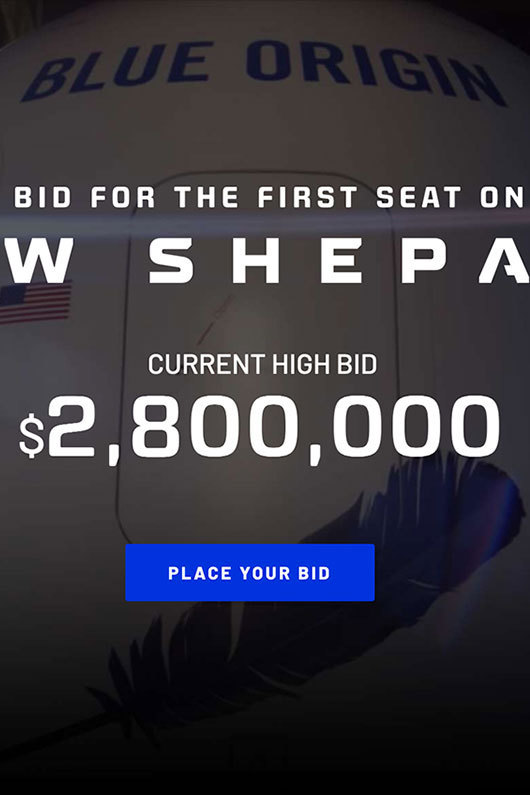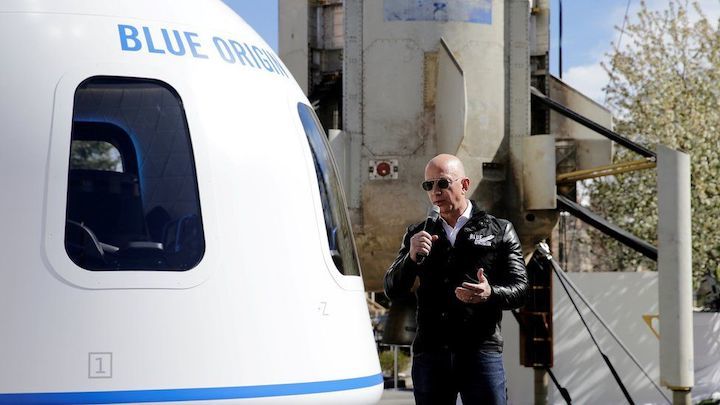Jeff Bezos will no longer be the richest person on Earth on 20 July because the Amazon founder will be blasting off into space on the first crewed flight of his New Shepard rocket ship.
Joining Bezos on the flight will be his younger brother, Mark, a former advertising executive and volunteer firefighter. The third member of the crew is being decided by a charity auction, with the seat currently priced at $2.8m (£2m) five days ahead of the deadline for bids.
“You see the Earth from space, it changes you,” Jeff Bezos said in a video announcing his plan. “It changes your relationship with this planet, with humanity. It’s one Earth. I want to go on this flight because it’s the thing I’ve wanted to do all my life. It’s an adventure. It’s a big deal for me.”

“I wasn’t even expecting him to say that he was going on the first flight,” Mark Bezos added. “And then when he asked me to go along, I was just awestruck. What a remarkable opportunity, not only to have this adventure, but to be able to do it with my best friend.”
The flight will take just minutes from start to finish, with three minutes of weightlessness as the crewed capsule brushes over an altitude of 100km, known as the Kármán line, the formal beginning for space. The booster rocket will land autonomously seven minutes after liftoff, and the crew capsule will float to earth on parachutes three minutes after that, with a planned touchdown in the West Texas desert.
Blue Origin, the spaceflight company Bezos founded in 2000, began testing its New Shepard vehicle in 2015. The system is named after Alan Shepard, the second person, and first American, in space, and the flight is timed to mark the 52nd anniversary of the Apollo 11 moon landing.
With massive windows to give an unparalleled view of Earth and comfortable seating for up to six people, New Shepard is explicitly designed to serve the space tourism market, and after Bezos’s inaugural flight, seats on future trips will be made available to the general public for an undisclosed price.
The system, comprising a single-stage rocket and crewed capsule, has carried out more than a dozen successful uncrewed tests so far, with the most recent April test flight a full dress rehearsal for next month’s launch.
Despite being first to be formally founded, Blue Origin has long sat in the shadow of Elon Musk’s spaceflight company, SpaceX. Both businesses have focused their research efforts on reducing the cost of launches, with their approaches converging on the idea of reusable booster rockets. But where Blue Origin decided to serve the space tourism market first, SpaceX began by offering cargo services to Nasa and other organisations that needed to place satellites in orbit.
Competition between the two has been fierce – and not just over technical achievements. SpaceX has been lobbying heavily against legislation that would split the contract to bring humans to the moon in two. Previously, SpaceX had expected to get the whole thing.
Musk’s company made its own first crewed launch in May 2020, sending two Nasa astronauts to orbit on the International Space Station (ISS). That flight, the first crewed launch from American soil since the final space shuttle mission returned in 2011, was also the first private flight to bring astronauts to the ISS. SpaceX has announced plans to bring space tourists into orbit “between late 2021 and mid-2022” in partnership with a company called Space Adventures. A seat on one of those flights is expected to cost slightly less than $50m (£35m).
Joining both companies in the space tourism business is Virgin Galactic. The company has yet to achieve space flight by international standards, which sets the boundary at 100km, and despite initial plans to fly paying customers into space in 2009, it still hasn’t done so. Last month it missed yet another deadline, but it did achieve its third successful test flight, to 90km.
Blue Origin’s own orbital launch vehicle, New Glenn, was expected to be ready by this year, but in February the company delayed its first launch to the fourth quarter of 2022. That rocket, named after John Glenn, the first American to orbit the earth, will be able to lift a 45 tonne payload into low Earth orbit, slightly less than the 64 tonnes that SpaceX’s flagship Falcon Heavy can manage.

The Boston-based auction firm has for 10 years now been organizing bi-annual sales dedicated to the relics of the space race, from astronaut-autographed photos to equipment that was flown to the moon.
The spacecraft seat RR Auction is selling now, though, is unlike anything that the company has sold before. It is not auctioning the chance to sit where an astronaut once sat, but rather the opportunity to become an astronaut by occupying the first commercially-available seat on Blue Origin's New Shepard suborbital rocket set to launch on July 20. Blue Origin founder Jeff Bezos and his brother Mark will join the auction winner on the flight.
"It's really wild," Bobby Livingston, RR Auction's executive vice president for public relations, said in an interview. "They want to go, and go now. It is an exciting group of people who have all dreamt of going."
The group who Livingston is referring to are the bidders, who since the single lot auction began on May 5, have driven the price of the seat to nearly $3 million. The bid as of Monday morning (June 7) stands at $2.8 million, which does not include a 6 percent buyer's premium (for a total of $2,968,000, were that the winning bid).
Blue Origin is not disclosing how many bidders, or bids, that total reflects, but has said that more than 5,200 people from more than 135 countries registered on its website for more information about the auction and to potentially take part. It then fell to RR Auction to ensure everyone who wanted to bid was qualified to do so.
"It is their website, but we are running the auction," said Livingston. "In order to execute a bid, they have to give RR Auction a $10,000 [non-refundable] deposit and they have to be vetted by us. We have talked to every perspective bidder over Zoom, so we are very much involved in the actual auction process."
In addition to being financially sound, bidders also needed to meet Blue Origin's requirements for flying aboard the New Shepard capsule. The winner must be at least 18 years old, be between 5 feet and 6 foot, 4 inches tall (152 and 193 cm), weigh between 110 and 223 pounds (50 and 101 kg) and be able to climb the launch tower — seven flights of stairs — in less than 90 seconds. He or she also must be able to sustain up to three times the force of gravity for up to two minutes and be able to reliably follow instructions by radio contact or alert lights.
For the first two weeks of the auction, from May 5 to May 19, all bids were sealed. The open bidding then began at $1.4 million and rose within the first day to $2.8 million, where it stands now.
Online bidding will remain open until 5 p.m. EDT (2100 GMT) on Thursday (June 10). The sale will then pause for two days before picking up with a live auction on Saturday (June 12) at 1 p.m. EDT (1700 GMT).
The break, says Livingston, was scheduled to allow for an anticipated demand.
"I expect a lot of last minute deposits and I have to vet everybody, so that was at my request because we have to have time to prepare," he said.
When the live auction gets underway, only those who raised their bid limit during the online bidding will be able to participate, but everyone will be able watch. Blue Origin will host a live webcast of the sale on its website and on YouTube.
Livingston expects the live auction will be exciting to watch.
"I think there's going to be plenty of people on the phone bidding that day. Now, we don't know what's going to happen between now and the 10th as far as if people are going to start bidding again, but I wouldn't be surprised if it goes a lot higher on the live auction day," he said.
Blue Origin is donating all proceeds from the auction to its non-profit organization, the Club For the Future, which is working to inspire future generations to pursue careers in science and technology and to help "invent the future of life in space."
As to who will win the auction, neither Blue Origin nor RR Auction are sharing any details about the bidders, but Livingston did say that more than a few seem to share an interest with his more typical auction participants.
"I know that a lot of the bidders collect or have some type of space memorabilia, because I have been on Zoom calls with them and can see what is behind them, on their walls and shelves," he told collectSPACE.
The $2.8 million bid already tops the highest amount RR Auction has received for anything related to space. The prior record was set in 2015, when RR Auction sold a Bulova chronograph worn the on surface of the moon for $1.625 million. (The most ever paid at a public auction for a piece of space memorabilia was the $2,055,000 received for a gold medallion flown to the moon by Neil Armstrong.)
RR Auction's agreement with Blue Origin precludes the firm from marketing their services to the bidders and Blue Origin's terms prevent the winner from selling any of the items he or she chooses to take on the New Shepard flight.
"Each astronaut is allowed to fly with a small bag of personal belongings and we hope they have such a special experience that they feel inspired to share their experience with others," a Blue Origin spokesperson said.





